In pics: "ancient village museum without bounding walls" in Jinxi County, E China
新華網(wǎng)
Editor: huaxia
2025-07-11 08:01:37
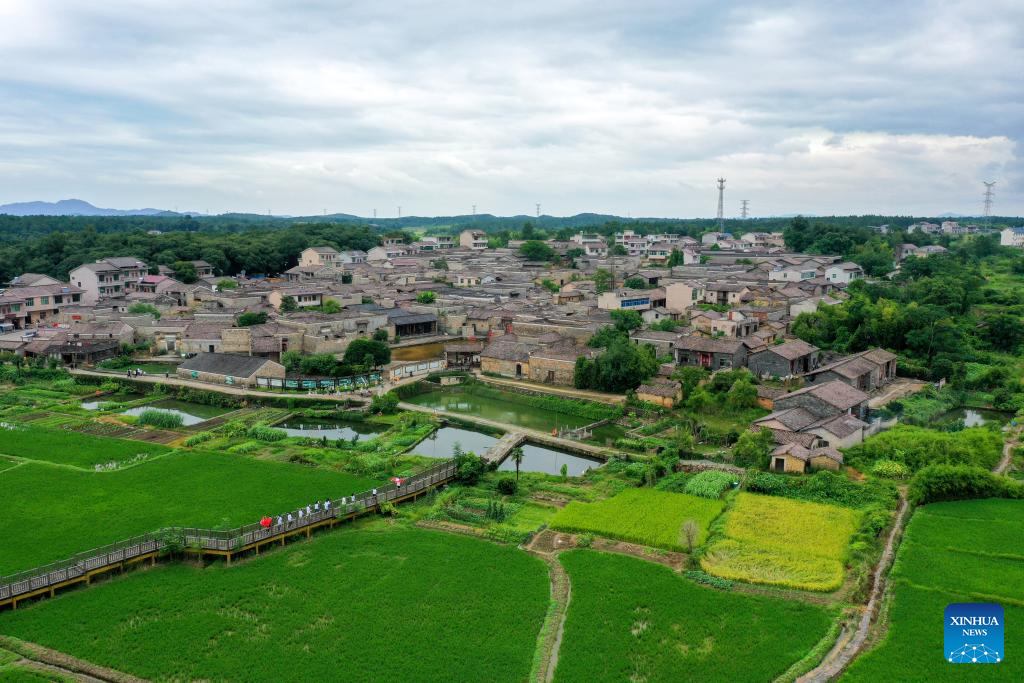
An aerial drone photo taken on July 9, 2025 shows a view of Zhuqiao Village in Jinxi County of Fuzhou, east China's Jiangxi Province. Jinxi County, with centuries-long history, still preserves over 100 ancient villages dating back to the Ming and Qing dynasties (1368-1911), which has won the county fame as an "ancient village museum without bounding walls." Zhuqiao is a prominent representative among the villages, featuring 109 existing ancient buildings from the Ming and Qing dynasties.
To maximize the preservation of its ancient charm, local authorities have continuously improved the infrastructure in Zhuqiao, systematically renovated historical buildings, and focused on developing industries such as cultural creativity, traditional Chinese medicine health services, and distinctive homestays.
In 2024, Zhuqiao Village welcomed around 514,300 visitors, and generated over 3 million yuan (about 418,018 U.S. dollars) in additional income for local villagers, establishing itself as a model of ancient village revitalization that integrates cultural experiences, intangible heritage studies, and rural tourism. (Xinhua/Liu Jinhai)
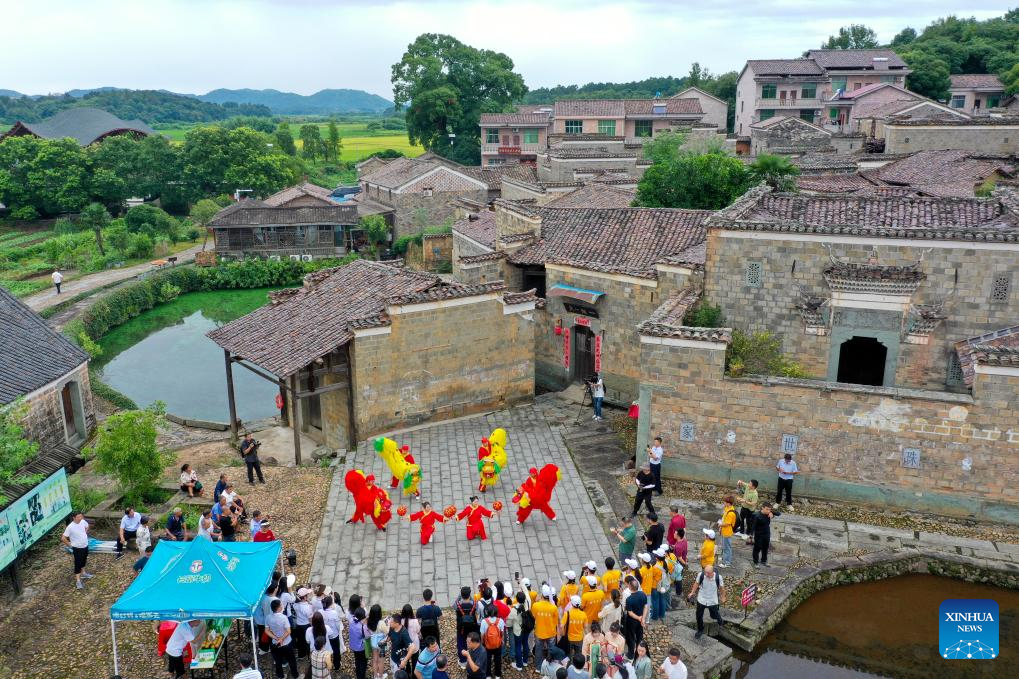
An aerial drone photo taken on July 9, 2025 shows tourists watching a folk performance in Zhuqiao Village, Jinxi County of Fuzhou, east China's Jiangxi Province. Jinxi County, with centuries-long history, still preserves over 100 ancient villages dating back to the Ming and Qing dynasties (1368-1911), which has won the county fame as an "ancient village museum without bounding walls." Zhuqiao is a prominent representative among the villages, featuring 109 existing ancient buildings from the Ming and Qing dynasties.
To maximize the preservation of its ancient charm, local authorities have continuously improved the infrastructure in Zhuqiao, systematically renovated historical buildings, and focused on developing industries such as cultural creativity, traditional Chinese medicine health services, and distinctive homestays.
In 2024, Zhuqiao Village welcomed around 514,300 visitors, and generated over 3 million yuan (about 418,018 U.S. dollars) in additional income for local villagers, establishing itself as a model of ancient village revitalization that integrates cultural experiences, intangible heritage studies, and rural tourism. (Xinhua/Liu Jinhai)
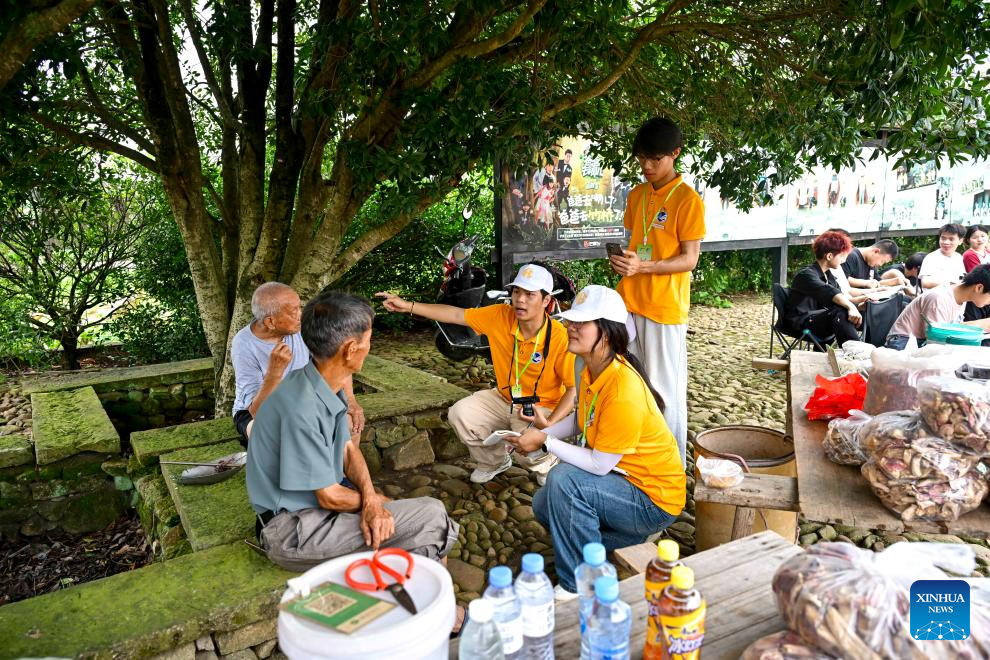
College students conduct research on the protection of historical buildings and the development of cultural tourism in Zhuqiao Village, Jinxi County of Fuzhou, east China's Jiangxi Province, July 9, 2025. Jinxi County, with centuries-long history, still preserves over 100 ancient villages dating back to the Ming and Qing dynasties (1368-1911), which has won the county fame as an "ancient village museum without bounding walls." Zhuqiao is a prominent representative among the villages, featuring 109 existing ancient buildings from the Ming and Qing dynasties.
To maximize the preservation of its ancient charm, local authorities have continuously improved the infrastructure in Zhuqiao, systematically renovated historical buildings, and focused on developing industries such as cultural creativity, traditional Chinese medicine health services, and distinctive homestays.
In 2024, Zhuqiao Village welcomed around 514,300 visitors, and generated over 3 million yuan (about 418,018 U.S. dollars) in additional income for local villagers, establishing itself as a model of ancient village revitalization that integrates cultural experiences, intangible heritage studies, and rural tourism. (Xinhua/Liu Jinhai)
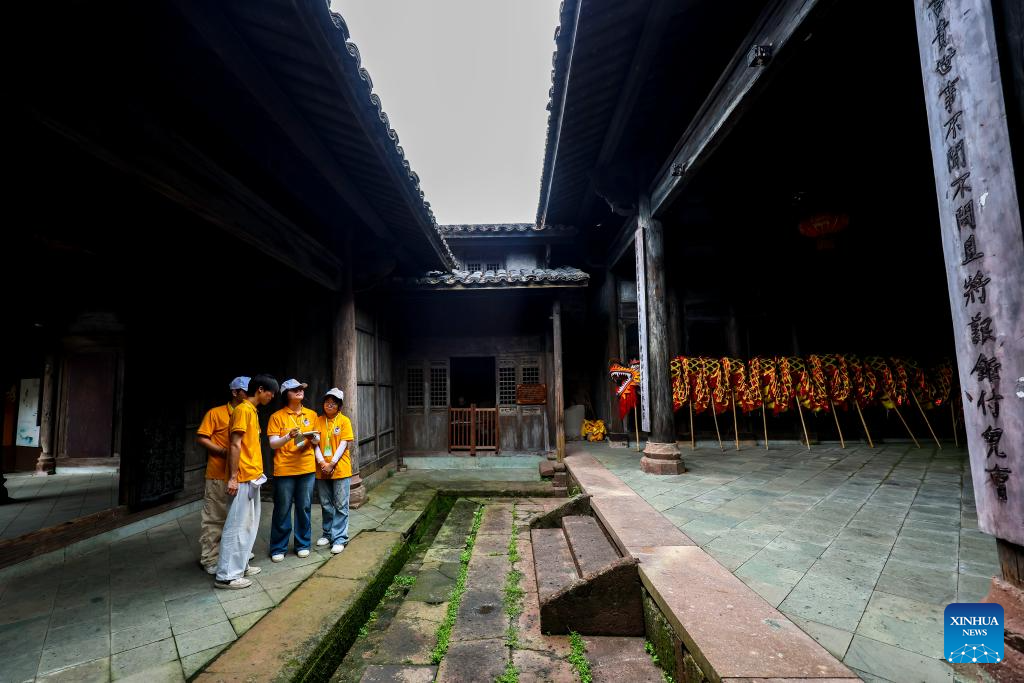
College students conduct research on the protection of historical buildings and the development of cultural tourism in Zhuqiao Village, Jinxi County of Fuzhou, east China's Jiangxi Province, July 9, 2025. Jinxi County, with centuries-long history, still preserves over 100 ancient villages dating back to the Ming and Qing dynasties (1368-1911), which has won the county fame as an "ancient village museum without bounding walls." Zhuqiao is a prominent representative among the villages, featuring 109 existing ancient buildings from the Ming and Qing dynasties.
To maximize the preservation of its ancient charm, local authorities have continuously improved the infrastructure in Zhuqiao, systematically renovated historical buildings, and focused on developing industries such as cultural creativity, traditional Chinese medicine health services, and distinctive homestays.
In 2024, Zhuqiao Village welcomed around 514,300 visitors, and generated over 3 million yuan (about 418,018 U.S. dollars) in additional income for local villagers, establishing itself as a model of ancient village revitalization that integrates cultural experiences, intangible heritage studies, and rural tourism. (Xinhua/Liu Jinhai)
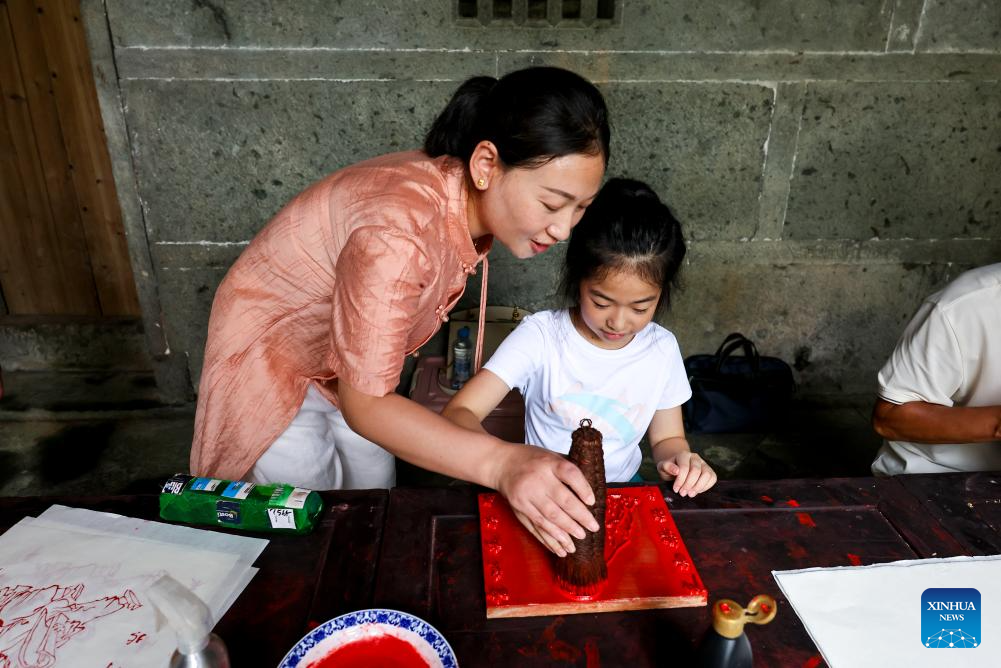
A child learns about woodblock printing technique in Zhuqiao Village, Jinxi County of Fuzhou, east China's Jiangxi Province, July 9, 2025. Jinxi County, with centuries-long history, still preserves over 100 ancient villages dating back to the Ming and Qing dynasties (1368-1911), which has won the county fame as an "ancient village museum without bounding walls." Zhuqiao is a prominent representative among the villages, featuring 109 existing ancient buildings from the Ming and Qing dynasties.
To maximize the preservation of its ancient charm, local authorities have continuously improved the infrastructure in Zhuqiao, systematically renovated historical buildings, and focused on developing industries such as cultural creativity, traditional Chinese medicine health services, and distinctive homestays.
In 2024, Zhuqiao Village welcomed around 514,300 visitors, and generated over 3 million yuan (about 418,018 U.S. dollars) in additional income for local villagers, establishing itself as a model of ancient village revitalization that integrates cultural experiences, intangible heritage studies, and rural tourism. (Xinhua/Liu Jinhai)

A livestreamer promotes local specialty fruit in Zhuqiao Village, Jinxi County of Fuzhou, east China's Jiangxi Province, July 9, 2025. Jinxi County, with centuries-long history, still preserves over 100 ancient villages dating back to the Ming and Qing dynasties (1368-1911), which has won the county fame as an "ancient village museum without bounding walls." Zhuqiao is a prominent representative among the villages, featuring 109 existing ancient buildings from the Ming and Qing dynasties.
To maximize the preservation of its ancient charm, local authorities have continuously improved the infrastructure in Zhuqiao, systematically renovated historical buildings, and focused on developing industries such as cultural creativity, traditional Chinese medicine health services, and distinctive homestays.
In 2024, Zhuqiao Village welcomed around 514,300 visitors, and generated over 3 million yuan (about 418,018 U.S. dollars) in additional income for local villagers, establishing itself as a model of ancient village revitalization that integrates cultural experiences, intangible heritage studies, and rural tourism. (Xinhua/Liu Jinhai)
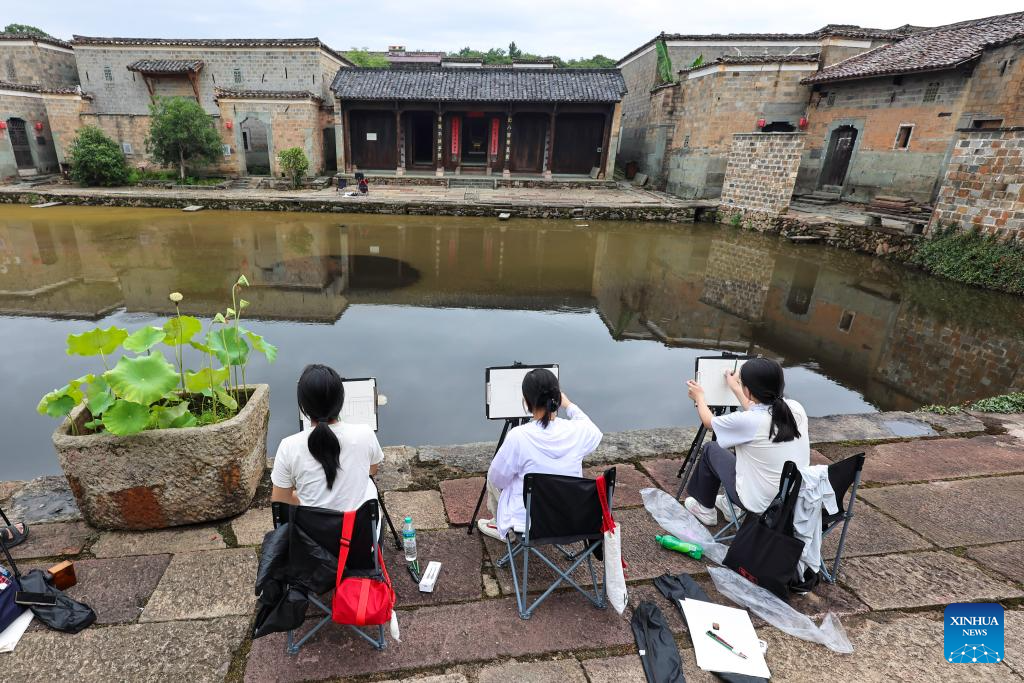
Teenagers sketch an ancient building in Zhuqiao Village, Jinxi County of Fuzhou, east China's Jiangxi Province, July 9, 2025. Jinxi County, with centuries-long history, still preserves over 100 ancient villages dating back to the Ming and Qing dynasties (1368-1911), which has won the county fame as an "ancient village museum without bounding walls." Zhuqiao is a prominent representative among the villages, featuring 109 existing ancient buildings from the Ming and Qing dynasties.
To maximize the preservation of its ancient charm, local authorities have continuously improved the infrastructure in Zhuqiao, systematically renovated historical buildings, and focused on developing industries such as cultural creativity, traditional Chinese medicine health services, and distinctive homestays.
In 2024, Zhuqiao Village welcomed around 514,300 visitors, and generated over 3 million yuan (about 418,018 U.S. dollars) in additional income for local villagers, establishing itself as a model of ancient village revitalization that integrates cultural experiences, intangible heritage studies, and rural tourism. (Xinhua/Liu Jinhai)
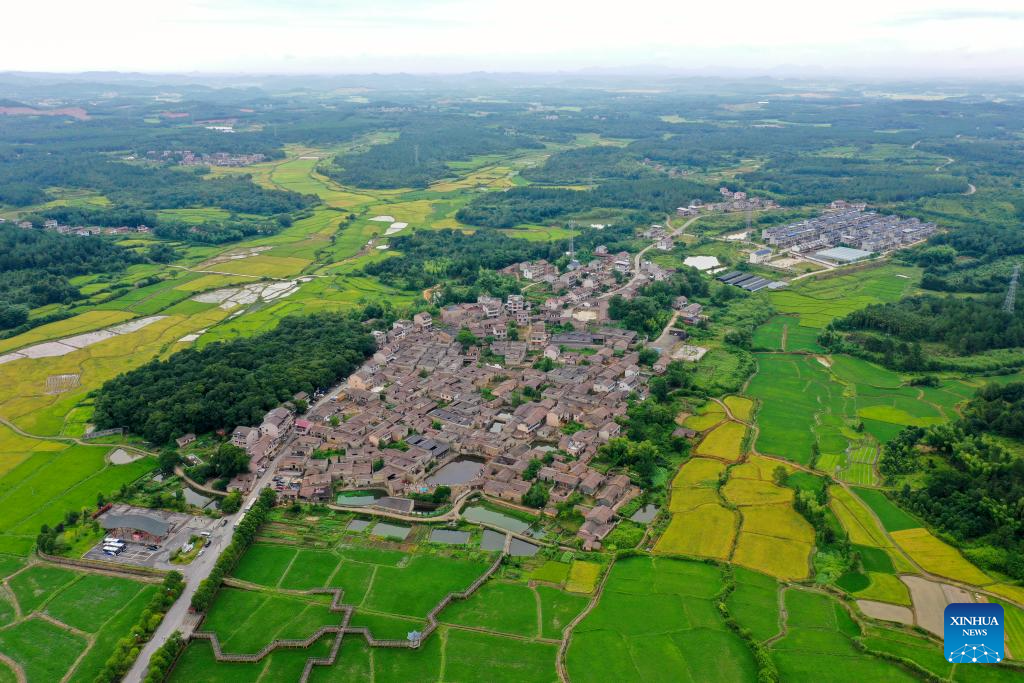
An aerial drone photo taken on July 9, 2025 shows a view of Zhuqiao Village in Jinxi County of Fuzhou, east China's Jiangxi Province. Jinxi County, with centuries-long history, still preserves over 100 ancient villages dating back to the Ming and Qing dynasties (1368-1911), which has won the county fame as an "ancient village museum without bounding walls." Zhuqiao is a prominent representative among the villages, featuring 109 existing ancient buildings from the Ming and Qing dynasties.
To maximize the preservation of its ancient charm, local authorities have continuously improved the infrastructure in Zhuqiao, systematically renovated historical buildings, and focused on developing industries such as cultural creativity, traditional Chinese medicine health services, and distinctive homestays.
In 2024, Zhuqiao Village welcomed around 514,300 visitors, and generated over 3 million yuan (about 418,018 U.S. dollars) in additional income for local villagers, establishing itself as a model of ancient village revitalization that integrates cultural experiences, intangible heritage studies, and rural tourism. (Xinhua/Liu Jinhai)
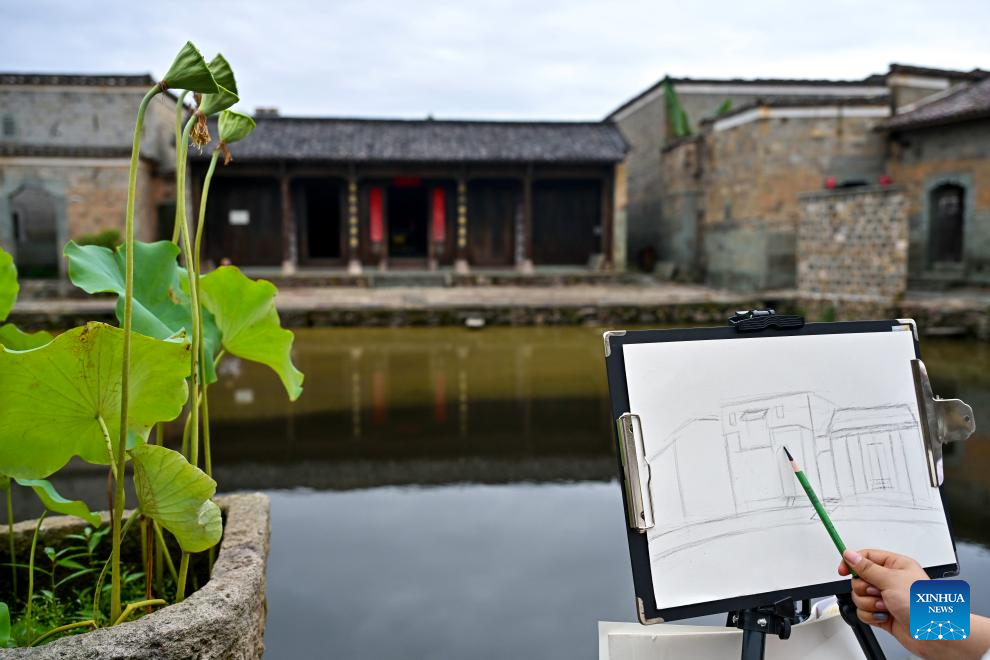
A teenager sketches an ancient building in Zhuqiao Village, Jinxi County of Fuzhou, east China's Jiangxi Province, July 9, 2025. Jinxi County, with centuries-long history, still preserves over 100 ancient villages dating back to the Ming and Qing dynasties (1368-1911), which has won the county fame as an "ancient village museum without bounding walls." Zhuqiao is a prominent representative among the villages, featuring 109 existing ancient buildings from the Ming and Qing dynasties.
To maximize the preservation of its ancient charm, local authorities have continuously improved the infrastructure in Zhuqiao, systematically renovated historical buildings, and focused on developing industries such as cultural creativity, traditional Chinese medicine health services, and distinctive homestays.
In 2024, Zhuqiao Village welcomed around 514,300 visitors, and generated over 3 million yuan (about 418,018 U.S. dollars) in additional income for local villagers, establishing itself as a model of ancient village revitalization that integrates cultural experiences, intangible heritage studies, and rural tourism. (Xinhua/Liu Jinhai)
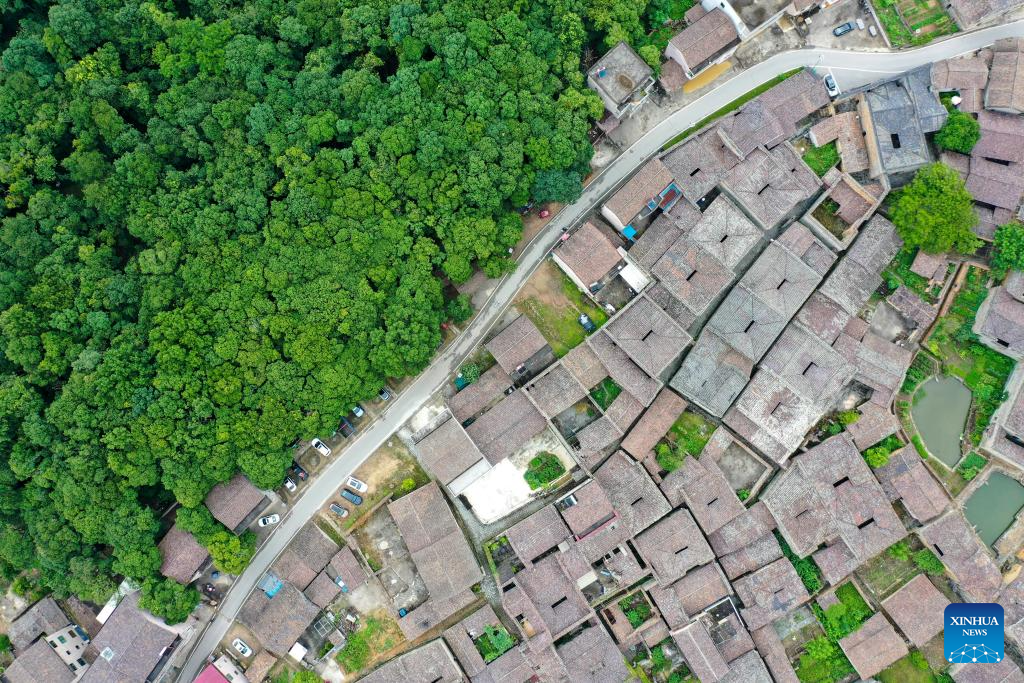
An aerial drone photo taken on July 9, 2025 shows a view of Zhuqiao Village in Jinxi County of Fuzhou, east China's Jiangxi Province. Jinxi County, with centuries-long history, still preserves over 100 ancient villages dating back to the Ming and Qing dynasties (1368-1911), which has won the county fame as an "ancient village museum without bounding walls." Zhuqiao is a prominent representative among the villages, featuring 109 existing ancient buildings from the Ming and Qing dynasties.
To maximize the preservation of its ancient charm, local authorities have continuously improved the infrastructure in Zhuqiao, systematically renovated historical buildings, and focused on developing industries such as cultural creativity, traditional Chinese medicine health services, and distinctive homestays.
In 2024, Zhuqiao Village welcomed around 514,300 visitors, and generated over 3 million yuan (about 418,018 U.S. dollars) in additional income for local villagers, establishing itself as a model of ancient village revitalization that integrates cultural experiences, intangible heritage studies, and rural tourism. (Xinhua/Liu Jinhai)
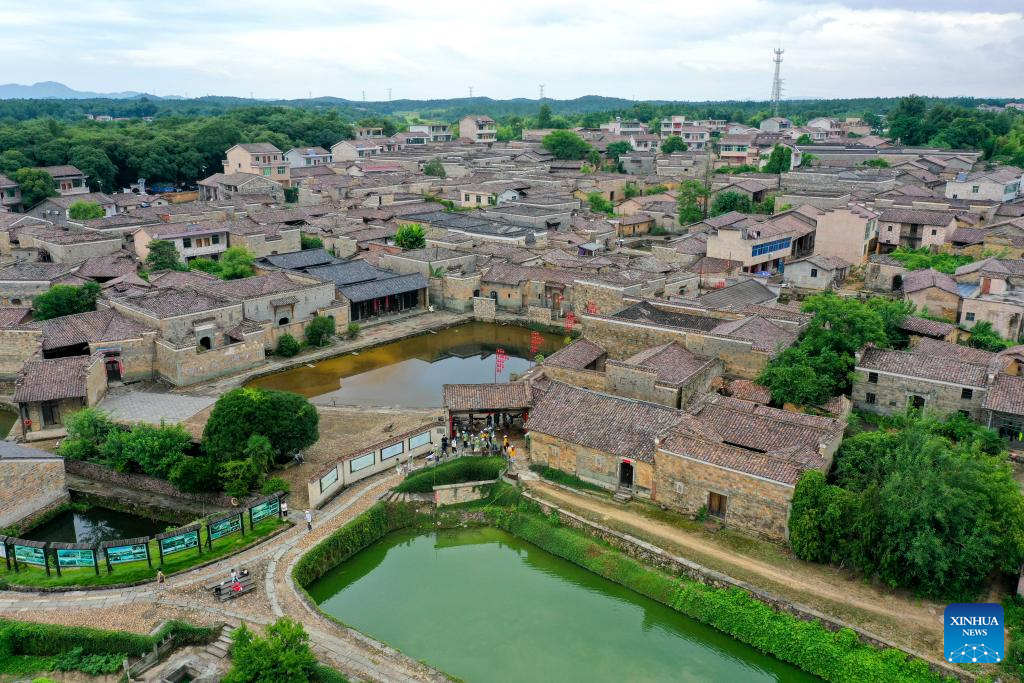
An aerial drone photo taken on July 9, 2025 shows a view of Zhuqiao Village in Jinxi County of Fuzhou, east China's Jiangxi Province. Jinxi County, with centuries-long history, still preserves over 100 ancient villages dating back to the Ming and Qing dynasties (1368-1911), which has won the county fame as an "ancient village museum without bounding walls." Zhuqiao is a prominent representative among the villages, featuring 109 existing ancient buildings from the Ming and Qing dynasties.
To maximize the preservation of its ancient charm, local authorities have continuously improved the infrastructure in Zhuqiao, systematically renovated historical buildings, and focused on developing industries such as cultural creativity, traditional Chinese medicine health services, and distinctive homestays.
In 2024, Zhuqiao Village welcomed around 514,300 visitors, and generated over 3 million yuan (about 418,018 U.S. dollars) in additional income for local villagers, establishing itself as a model of ancient village revitalization that integrates cultural experiences, intangible heritage studies, and rural tourism. (Xinhua/Liu Jinhai)

College students learn about the cultural heritage and ancient building preservation of Zhuqiao Village in Jinxi County of Fuzhou, east China's Jiangxi Province, July 9, 2025. Jinxi County, with centuries-long history, still preserves over 100 ancient villages dating back to the Ming and Qing dynasties (1368-1911), which has won the county fame as an "ancient village museum without bounding walls." Zhuqiao is a prominent representative among the villages, featuring 109 existing ancient buildings from the Ming and Qing dynasties.
To maximize the preservation of its ancient charm, local authorities have continuously improved the infrastructure in Zhuqiao, systematically renovated historical buildings, and focused on developing industries such as cultural creativity, traditional Chinese medicine health services, and distinctive homestays.
In 2024, Zhuqiao Village welcomed around 514,300 visitors, and generated over 3 million yuan (about 418,018 U.S. dollars) in additional income for local villagers, establishing itself as a model of ancient village revitalization that integrates cultural experiences, intangible heritage studies, and rural tourism. (Xinhua/Liu Jinhai)
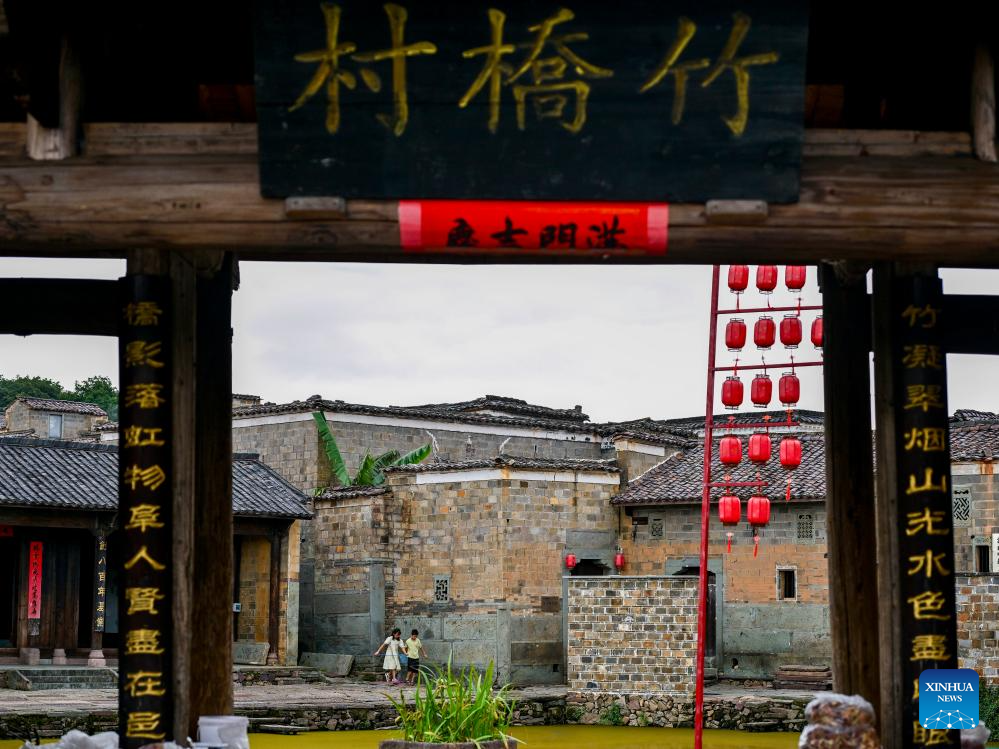
This photo taken on July 9, 2025 shows a view of Zhuqiao Village in Jinxi County of Fuzhou, east China's Jiangxi Province. Jinxi County, with centuries-long history, still preserves over 100 ancient villages dating back to the Ming and Qing dynasties (1368-1911), which has won the county fame as an "ancient village museum without bounding walls." Zhuqiao is a prominent representative among the villages, featuring 109 existing ancient buildings from the Ming and Qing dynasties.
To maximize the preservation of its ancient charm, local authorities have continuously improved the infrastructure in Zhuqiao, systematically renovated historical buildings, and focused on developing industries such as cultural creativity, traditional Chinese medicine health services, and distinctive homestays.
In 2024, Zhuqiao Village welcomed around 514,300 visitors, and generated over 3 million yuan (about 418,018 U.S. dollars) in additional income for local villagers, establishing itself as a model of ancient village revitalization that integrates cultural experiences, intangible heritage studies, and rural tourism. (Xinhua/Liu Jinhai)

College students visit Zhuqiao Village in Jinxi County of Fuzhou, east China's Jiangxi Province, July 9, 2025. Jinxi County, with centuries-long history, still preserves over 100 ancient villages dating back to the Ming and Qing dynasties (1368-1911), which has won the county fame as an "ancient village museum without bounding walls." Zhuqiao is a prominent representative among the villages, featuring 109 existing ancient buildings from the Ming and Qing dynasties.
To maximize the preservation of its ancient charm, local authorities have continuously improved the infrastructure in Zhuqiao, systematically renovated historical buildings, and focused on developing industries such as cultural creativity, traditional Chinese medicine health services, and distinctive homestays.
In 2024, Zhuqiao Village welcomed around 514,300 visitors, and generated over 3 million yuan (about 418,018 U.S. dollars) in additional income for local villagers, establishing itself as a model of ancient village revitalization that integrates cultural experiences, intangible heritage studies, and rural tourism. (Xinhua/Liu Jinhai)
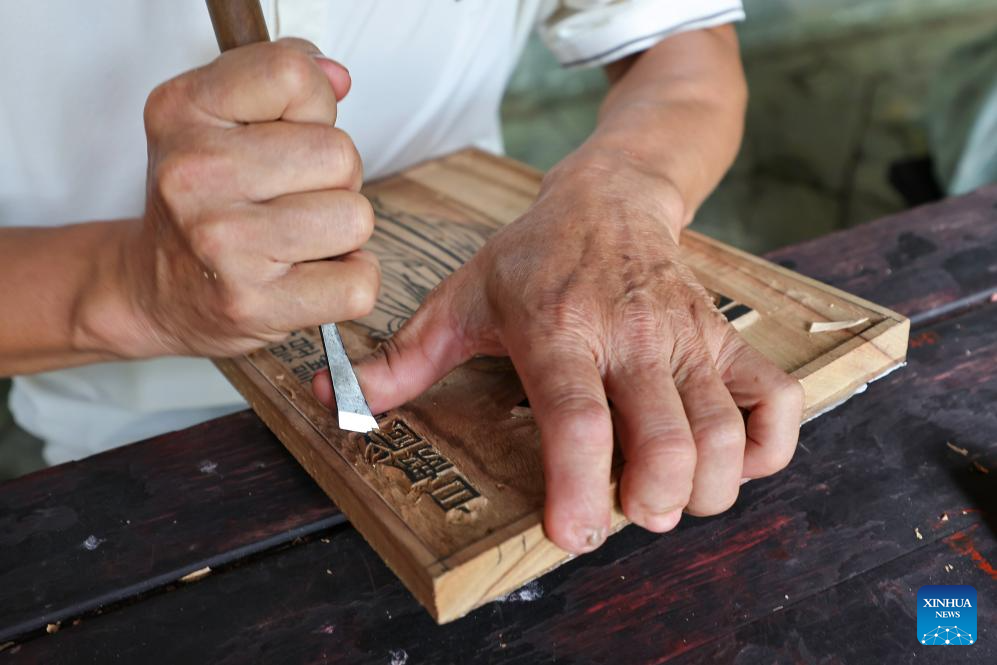
An artisan demonstrates woodblock printing technique in Zhuqiao Village, Jinxi County of Fuzhou, east China's Jiangxi Province, July 9, 2025. Jinxi County, with centuries-long history, still preserves over 100 ancient villages dating back to the Ming and Qing dynasties (1368-1911), which has won the county fame as an "ancient village museum without bounding walls." Zhuqiao is a prominent representative among the villages, featuring 109 existing ancient buildings from the Ming and Qing dynasties.
To maximize the preservation of its ancient charm, local authorities have continuously improved the infrastructure in Zhuqiao, systematically renovated historical buildings, and focused on developing industries such as cultural creativity, traditional Chinese medicine health services, and distinctive homestays.
In 2024, Zhuqiao Village welcomed around 514,300 visitors, and generated over 3 million yuan (about 418,018 U.S. dollars) in additional income for local villagers, establishing itself as a model of ancient village revitalization that integrates cultural experiences, intangible heritage studies, and rural tourism. (Xinhua/Liu Jinhai)



